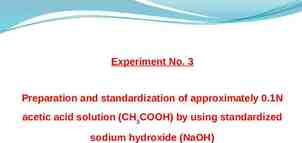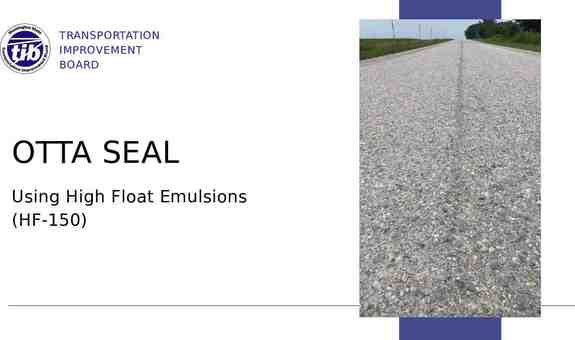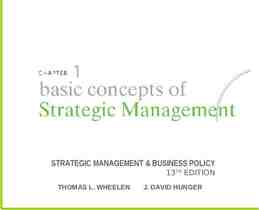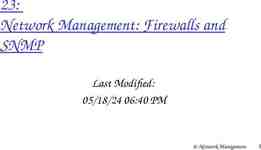THE ROLES OF BEST PRACTICES & INNOVATION IN ORGANIZATIONAL
43 Slides740.00 KB
THE ROLES OF BEST PRACTICES & INNOVATION IN ORGANIZATIONAL EFFECTIVENESS DR. FREDERICK DEMBOWSKI Hibernia National Bank Endowed Professor Emeritus, Southeastern Louisiana University President, The International Association Of Organizational Innovation BANGKOK, THAILAND AUGUST, 2010 THE INTERNATIONAL ASSOCIATION OF ORGANIZATIONAL INNOVATION
To View This Presentation Online, Go To: http://ijoi.fp.expressacademic.org/index.php To Contact the Author, Email: [email protected] THE INTERNATIONAL ASSOCIATION OF ORGANIZATIONAL INNOVATION
WHY ARE YOU IN EXISTENCE? All Organizations Have a Purpose: To Meet the Needs & Wants of Their Clients/Customers They Must Continue Doing This In Order To Survive (& Make Money!?) THE INTERNATIONAL ASSOCIATION OF ORGANIZATIONAL INNOVATION
CAMERON & WHETTON (1983) WROTE THE SEMINAL RESEARCH BOOK ON ORGANIZATIONAL EFFECTIVENESS. ACCORDING TO THEM, ALL ORGANIZATIONS HAVE PHASES IN THEIR LIFE CYCLE THAT HAVE A FOCUS ON: MAINTENANCE IMPROVEMENT DEVELOPMENT THE INTERNATIONAL ASSOCIATION OF ORGANIZATIONAL INNOVATION
(Adapted from: Cameron, Kim S., and Whetton, David A. (1983) Organizational Effectiveness: a Comparison of Multiple Models, Academic Press.) THE INTERNATIONAL ASSOCIATION OF ORGANIZATIONAL INNOVATION
THE FUNCTIONS OF MANAGEMENT VARY IN EACH OF THE PHASES OF THE LIFE CYCLE OF AN ORGANIZATION (Dembowski & Eckstrom, 1999) THE INTERNATIONAL ASSOCIATION OF ORGANIZATIONAL INNOVATION
MANAGEMENT OPERATIONS IN THE THREE PHASES OF AN ORGANIZATION'S LIFE CYCLE I. Maintenance of the Operations of the Organization (Short Term/Annually) II. Improvement of Operations (Ongoing) III. Organizational Development (Longer Term) KEY OPERATIONS!! Adapted from: Dembowski, F.L., & Ekstrom, C. (1999). Effective School District Management: A Self-Review Instrument and Guide, Arlington, VA: The American Association of School Administrators (1999) and Scarecrow Press (2001). THE INTERNATIONAL ASSOCIATION OF ORGANIZATIONAL INNOVATION
MAINTENANCE Performing the Operations of the Organization (Short Term Or Annual) Includes: a. Budgeting b. Review of Policies, Rules & Regulations c. Review of Operating Procedures d. Program Review & Planning THE INTERNATIONAL ASSOCIATION OF ORGANIZATIONAL INNOVATION
IMPROVEMENT Analysis of the Operations of the Organization (Continual) Includes: a. Problem Solving & Systems Analysis b. Continuous Improvement (TQM) c. Best Practices THE INTERNATIONAL ASSOCIATION OF ORGANIZATIONAL INNOVATION
DEVELOPMENT A Re-examination of the Purpose of the Organization’s Processes, Products & Services (Longer Term?) Includes: a. Strategic Planning b. Restructuring & Re-Engineering c. Innovation THE INTERNATIONAL ASSOCIATION OF ORGANIZATIONAL INNOVATION
EFFECTIVENESS IS DOING THE RIGHT THING! EFFICIENCY IS GETTING "IT" DONE AT A LOW (OPTIMAL?) UNIT COST! ORGANIZATIONS STRIVE TO BE EFFICIENT AND EFFECTIVE. A "BEST PRACTICE" IS THE OPTIMIZATION OF THE EFFECTIVENESS OF AN ORGANIZATION WHAT IS A "BEST PRACTICE” & HOW IS IT ATTAINED? THE INTERNATIONAL ASSOCIATION OF ORGANIZATIONAL INNOVATION
BEST PRACTICES MODEL Adapted from: “Best Practice in Park Interpretation and Education: A Report to the ANZECC Working Group on National Park and Protected Area Management”, Department of Natural Resources and Environment, Victoria New Zealand, April 1999 THE INTERNATIONAL ASSOCIATION OF ORGANIZATIONAL INNOVATION
THE STAGES OF INSTITUTING A BEST PRACTICE: I. DEFINE II. DEVELOP III. DELIVER IV. EVALUATE V. SUPPORT THE INTERNATIONAL ASSOCIATION OF ORGANIZATIONAL INNOVATION
BEST PRACTICES: STAGE 1 - DEFINE The DEFINE Stage Considers Issues Such As: - Rationale - Benefits and Outcomes - Goals and Functions - Relationship to Other Organization Functions THE INTERNATIONAL ASSOCIATION OF ORGANIZATIONAL INNOVATION
BEST PRACTICES: STAGE 2 - DEVELOP THE INTERNATIONAL ASSOCIATION OF ORGANIZATIONAL INNOVATION
BEST PRACTICES: II. The DEVELOP stage includes: - Establishing objectives - Mapping and analyzing customer needs - Formulating and refining messages - Setting Performance Standards - Setting Key Performance Indicators - Identifying key secondary customers - Weighing costs against benefits - Designing appropriate method and options for product/service delivery - Specifying relationships THE INTERNATIONAL ASSOCIATION OF ORGANIZATIONAL INNOVATION
BEST PRACTICES: STAGE 3 - DELIVER THE INTERNATIONAL ASSOCIATION OF ORGANIZATIONAL INNOVATION
BEST PRACTICES: III. The DELIVER stage includes: 1. Controlling Delivery To Ensure Services Are In Accordance With Target Objectives, Timeliness, Budget And Standards 2. Seeking Feedback To Monitor The Effectiveness Of Products/Services And Improve Day-to-day Performance 3. Communicating Internally Across Organization's Operating Units And Externally With The Organization's Customer Base To Support Effective Delivery 4. Designing Work Routines And Job Responsibilities For Effective Delivery Of Products/Services THE INTERNATIONAL ASSOCIATION OF ORGANIZATIONAL INNOVATION
BEST PRACTICES: STAGE 4 - EVALUATE THE INTERNATIONAL ASSOCIATION OF ORGANIZATIONAL INNOVATION
BEST PRACTICES: IV. The EVALUATE Stage Checks That Products/ Services The Organization Delivers Are Regularly And Systematically Assessed For: 1. Effectiveness In Achieving Stated Outcomes 2. The Level To Which Performance Standards Have Been Met 3. Degree To Which Performance Indicators Have Been Achieved 4. Continuing Relevance Of Objectives And Design Features 5. Wider Anticipated Or Unanticipated Impacts THE INTERNATIONAL ASSOCIATION OF ORGANIZATIONAL INNOVATION
BEST PRACTICES: STAGE 5 - SUPPORT THE INTERNATIONAL ASSOCIATION OF ORGANIZATIONAL INNOVATION
BEST PRACTICES: V. The SUPPORT Function Mainly Addresses Responsibilities Such As: * Human Resources, Skills and Deployment * Financial Systems * Technology, Equipment, and Supply Of Materials. The preceding material on Best Practices was adapted from: “Best Practice in Park Interpretation and Education: A Report to the ANZECC Working Group on National Park and Protected Area Management”, Department of Natural Resources and Environment, Victoria New Zealand, April 1999 THE INTERNATIONAL ASSOCIATION OF ORGANIZATIONAL INNOVATION
What Happens If You Are Producing Goods Or Services In An Optimal Manner (Best Practice) And Your Customers Are STILL NOT SATISFIED? That Is When You Need To Explore The DEVELOPMENT Stage Of Your Organization! THE Development Stage Consists of: a. Strategic Planning b. Restructuring & Re-Engineering c. Innovation Adapted from Dembowski, F. (1997) THE INTERNATIONAL ASSOCIATION OF ORGANIZATIONAL INNOVATION
What is Innovation? INNOVATION Is PEOPLE Implementing Ideas That Create New Value. INNOVATION Has Several Key Factors: The InnovationDNA Model (Developed by: the InnovationNetwork) THE INTERNATIONAL ASSOCIATION OF ORGANIZATIONAL INNOVATION
What's Your Innovation Quotient? Survey of People-Practices in Innovation : Knowing Where to Begin InnovationNetwork, 2004 – 2010 Every organization is doing innovation at some level of expertise. If you want to improve your innovation capabilities, you need to know where to focus your efforts. THE INTERNATIONAL ASSOCIATION OF ORGANIZATIONAL INNOVATION
What's Your Organization's I*Q (Innovation Quotient)? The following questions will help you see where your organization stands. Please rate these 10 questions as candidly as possible. Ratings: 1 never/probably not; 2 sometimes/possibly 3. generally/maybe 4. usually/probably 5. always/definitely! 1. Does at least 25% of your revenue come from products and services developed in the past 5 years? 2. Do you consistently outperform your competition in things like customer service, quality, time to market, ROI, and profitability? 3. Do you routinely solicit, listen to, and act on suggestions from people from every level and function of your organization? THE INTERNATIONAL ASSOCIATION OF ORGANIZATIONAL INNOVATION
4. Do you encourage and stimulate interaction between departments and promote cross-functional projects? 5. Have all of your improvement processes (TQM, reengineering, excellence, etc.) been as effective as you hoped? 6. Do you regularly train people at all levels and in every function how to think and work together more effectively? 7. Do people in your organization regularly have time available to think through situations, look at the big picture, bounce ideas off of peers, and experiment with possibilities? 8. Is information freely and readily available to everyone in your organization rather than on a need-to-know-basis? 9. Does your organization regularly review and update its assumptions, mission and goals and encourage everyone in the organization to do so also? 10. Is ownership, rewards and risks, distributed widely through your organization through stock ownership plans or profit sharing plans? What Is Your Innovation Quotient? Add up the points for the 10 questions. THE INTERNATIONAL ASSOCIATION OF ORGANIZATIONAL INNOVATION
What Is Your Innovation Quotient? 1-14 - Your organization has a shaky grasp of innovation! If you don’t take immediate action, the world may be passing you by! 15-29 - You need an information boost! Organize some informal groups & start talking about innovation. Look at the questions that you rated the lowest & see if others agree with your assessment. 30-44 - You are on the right track! But you need to open your lines of communication! Ask all people in your organization what would make their work life better. What tools do they need? What information do they need? Do they understand their work processes & how they fit into the whole? 45-50 - Congratulations! Somehow you have managed to do what everyone else is talking about doing. For more information, see: http://www.innovationnetwork.biz/mission/dna/index.html THE INTERNATIONAL ASSOCIATION OF ORGANIZATIONAL INNOVATION
InnovationDNA : Framework of Principles Developed by: InnovationNetwork www.innovationnetwork.biz THE INTERNATIONAL ASSOCIATION OF ORGANIZATIONAL INNOVATION
InnovationDNA : COMPONENTS: Context: Interactions With Customers, Suppliers, Competitors & the Economy, Government, World Events, Communities and Families Leadership: Role Models Who See the Possibilities For the Future. People: The Source of Innovation. Basic Values: The Backbone That Defines an Organization. Innovation Values: The Mindset That Makes the Impossible Possible. THE INTERNATIONAL ASSOCIATION OF ORGANIZATIONAL INNOVATION
Entryways and Outcomes of the InnovationDNA Entryways to Innovation Ideas, Change, Passion and Trends These Are The Innovation Drivers. Outcomes to Innovation The Outcomes Lead To Yet Another Cycle: Renewal, Change, Reinvention, Trends THE INTERNATIONAL ASSOCIATION OF ORGANIZATIONAL INNOVATION
InnovationDNA Operational Elements of the Innovation DNA How Do These Principles Show Up In Real Life? Here Are Brief Descriptions of the Model’s Concepts: THE INTERNATIONAL ASSOCIATION OF ORGANIZATIONAL INNOVATION
CHALLENGE Innovation Means Doing Things Differently, Exploring New Territory, Taking Risks (Going Out On A Limb!) There Is Nothing That Pulls Innovation As Much As A Challenge That Captures the Imagination. It Happens In Organizations Big and Small Every Time People Are Excited By the Possibilities of Creating Better Products and Services and To Make A Difference In the World. THE INTERNATIONAL ASSOCIATION OF ORGANIZATIONAL INNOVATION
CUSTOMER FOCUS All innovation should be focused on creating value for the customer, internal & external. Interaction with customers and understanding of their needs are the best stimulators of new possibilities and the motivation for implementing them A constant stream of ideas and innovation is created when everyone in an organization can identify with their customer(s). When the customer is a real presence to people, they get excited about finding new ways to add value Listening to customers is a priority here! THE INTERNATIONAL ASSOCIATION OF ORGANIZATIONAL INNOVATION
CREATIVITY Everything starts from an idea Great ideas generating a lot of possibilities. Leadership to foster the climate that encourages “blue sky” thinking and offers direction and stimuli to spur creativity. Individuals must embrace challenges & push the boundaries of their thinking. If you want ideas you have to create incentives that attracts them. A core value is Curiosity: “There's Got to Be a Better Way.” THE INTERNATIONAL ASSOCIATION OF ORGANIZATIONAL INNOVATION
COMMUNICATION Open Communication of Information, Ideas and Feelings Both Infrastructure and Advocacy Must Exist To Promote the Free Flow of Information. Leadership Must Model the Practices and Behaviors of Innovation Organizations That Restrict Communication and Fail To “Think Together” Risk Disaster. Sharing Information, Ideas, Experiences and Learning Is the Lifeblood of Innovation. THE INTERNATIONAL ASSOCIATION OF ORGANIZATIONAL INNOVATION
COLLABORATION Innovation Is Group Process. It Requires Interaction, Information And The Power Of Teams. Multi-level And Cross Functional Project: --- Teams Bring Diversity: --- The Broadest Perspectives, --- The Most Ideas & ---The Greatest Abilities To Implement To Any Innovation Effort. Innovation Is A Team Sport. It Takes The Collaboration Of Lots Of People To Successfully Implement An Idea. THE INTERNATIONAL ASSOCIATION OF ORGANIZATIONAL INNOVATION
COMPLETION Moving New Ideas Forward Into Reality Requires The Exploration Or Experimentation With A Variety Of Alternatives To Yield Superior Results. Innovations Require Projects That Have Defined Processes And Strong Implementation Skills: Decision-making, Delegating, Scheduling, Monitoring, And Feedback. When Projects Are Completed, They Should Be Celebrated. Innovative Organizations Take New Products To Market Quickly! THE INTERNATIONAL ASSOCIATION OF ORGANIZATIONAL INNOVATION
CONTEMPLATION Making objective assessments of outcomes and costs of new projects is essential. Gleaning the lessons learned from both fruitful and failed projects adds muscle to the cycle of success. When adopted in a disciplined approach, contemplation adds invaluably to organizational wisdom. Innovative organizations develop ways to collect and share the lessons to create "wisdom systems". Create “learning histories” to capture lessons learned on new product development. THE INTERNATIONAL ASSOCIATION OF ORGANIZATIONAL INNOVATION
CULTURE Culture is the "playing field" for all innovation projects and activities. The organization must nurture the seeds of ideas and solutions to grow a culture that provides the climate for innovation to occur. The Culture for Innovation requires: trust and respect, the willingness to take risks, the freedom to make choices, a continuous scanning for new trends, a commitment to systematically look for new ways to do things, and an equitable sharing of risks and rewards. THE INTERNATIONAL ASSOCIATION OF ORGANIZATIONAL INNOVATION
So, What Are the Roles of Best Practices and Innovation In an Organization? In Order To Be Effective and To Survive, Your Organization Must Acquire Both Best Practices and Innovations. Both Are Achievable, But Require Systematic Effort. Good Luck!! THE INTERNATIONAL ASSOCIATION OF ORGANIZATIONAL INNOVATION
To View This Presentation Online, Go To: http://ijoi.fp.expressacademic.org/index.php To Contact the Author, Email: [email protected] THE INTERNATIONAL ASSOCIATION OF ORGANIZATIONAL INNOVATION
References used in this presentation: Cameron, Kim S., and Whetton, David A. (1983) Organizational Effectiveness: a Comparison of Multiple Models, Academic Press.) “Best Practice in Park Interpretation and Education: A Report to the ANZECC Working Group on National Park and Protected Area Management” Department of Natural Resources and Environment, Victoria New Zealand, April 1999 Dembowski, F., “The Roles of Leadership and Management in School District Administration”, the AASA Professor, vol. 20, no. 2 Fall, 1997. Dembowski, F and Eckstrom, C., Effective School District Management, American Association of School Administrators, Arlington, Virginia 1999. The Innovation Network, www.innovationnetwork.biz What is your Innovation Quotient? http://www.innovationnetwork.biz/mission/dna/index.html THE INTERNATIONAL ASSOCIATION OF ORGANIZATIONAL INNOVATION
















































